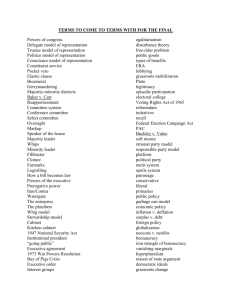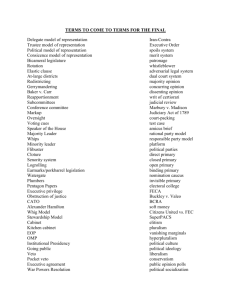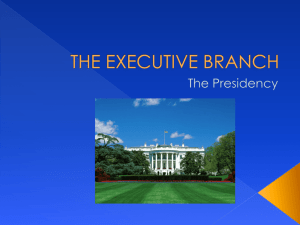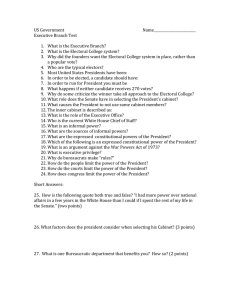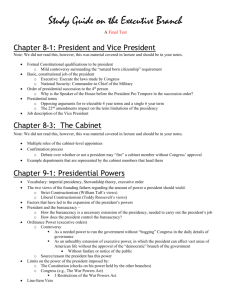TERMS TO COME TO TERMS WITH FOR THE FINAL Powers of
advertisement
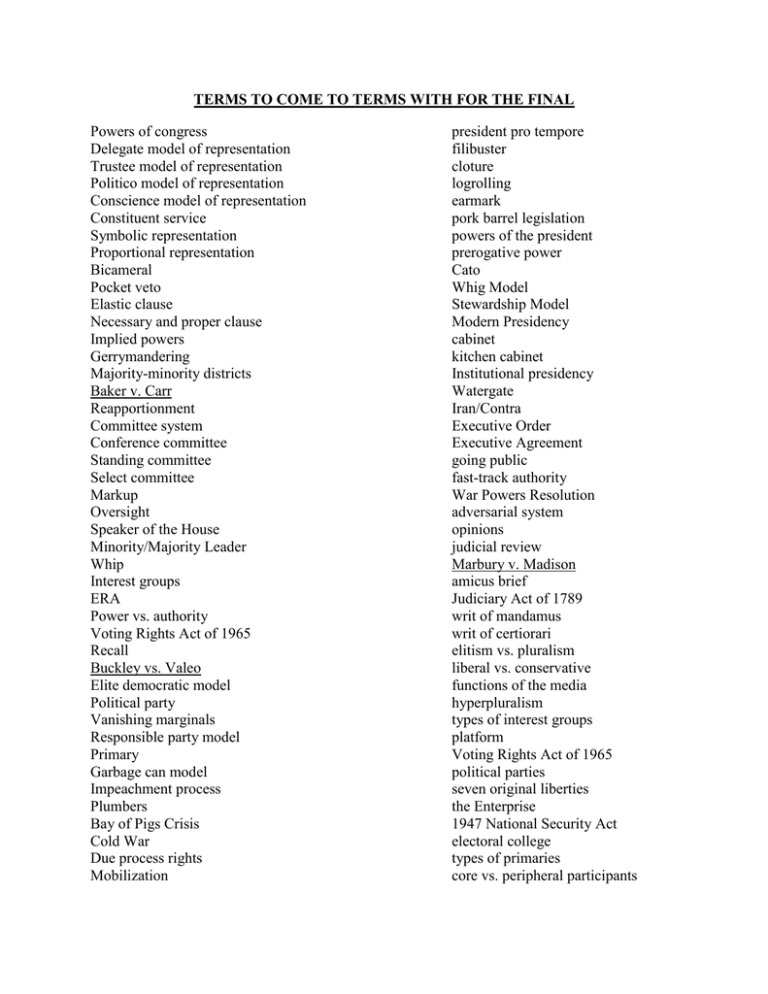
TERMS TO COME TO TERMS WITH FOR THE FINAL Powers of congress Delegate model of representation Trustee model of representation Politico model of representation Conscience model of representation Constituent service Symbolic representation Proportional representation Bicameral Pocket veto Elastic clause Necessary and proper clause Implied powers Gerrymandering Majority-minority districts Baker v. Carr Reapportionment Committee system Conference committee Standing committee Select committee Markup Oversight Speaker of the House Minority/Majority Leader Whip Interest groups ERA Power vs. authority Voting Rights Act of 1965 Recall Buckley vs. Valeo Elite democratic model Political party Vanishing marginals Responsible party model Primary Garbage can model Impeachment process Plumbers Bay of Pigs Crisis Cold War Due process rights Mobilization president pro tempore filibuster cloture logrolling earmark pork barrel legislation powers of the president prerogative power Cato Whig Model Stewardship Model Modern Presidency cabinet kitchen cabinet Institutional presidency Watergate Iran/Contra Executive Order Executive Agreement going public fast-track authority War Powers Resolution adversarial system opinions judicial review Marbury v. Madison amicus brief Judiciary Act of 1789 writ of mandamus writ of certiorari elitism vs. pluralism liberal vs. conservative functions of the media hyperpluralism types of interest groups platform Voting Rights Act of 1965 political parties seven original liberties the Enterprise 1947 National Security Act electoral college types of primaries core vs. peripheral participants STUDY QUESTIONS FOR THE FINAL 1. 2. 3. 4. 5. 6. Describe the models of representation. Explain the constitutional powers of congress. Describe the committee system. What is the role of political parties in legislating successfully? Explain step by step how a bill becomes a law. What is a bicameral system? Describe the main differences between the House and the Senate? 7. What is the difference between apportionment and gerrymandering? 8. Describe the Texas redistricting battle. 9. What did the case Baker v. Carr entail and what precedence did it set? 10. Describe the organization of congress. 11. What is the difference between a filibuster and cloture? 12. What is the seniority system in congress? 13. What is an earmark? Give two examples from the current congress. 14. What is the difference between a veto and a pocket veto? 15. Describe the basics of Watergate. 16. Describe the basics of Iran/Contra. 17. What is the difference between the plumbers and the enterprise? 18. Why is the 1947 National Security Act a turning point in balance of power between the Executive and the other two branches? 19. Describe the constitutional powers of the president. 20. Why did “Cato” oppose ratification of the constitution? 21. Describe the presidential models of leadership. 22. What is the difference between the cabinet and the kitchen cabinet? Which president is responsible for the creation of the kitchen cabinet? 23. Describe the modern role of the Vice President in the executive branch. 24. What are the duties, responsibilities, and functions of the modern president? 25. Explain the difference between an executive order and an executive agreement. 26. Explain the War Powers Resolution of 1973. 27. Describe three of the key character traits of a successful president. 28. What is bureaucracy? 29. What is the difference between the spoils system and the merit system? Which president started the spoils system? 30. What constitutional foundations allow citizens to petition their government? 31. Why are interest groups important to the democratic process? 32. Explain the concept of egalitarianism. 33. Describe the main functions of interest groups. 34. Describe three types of interest groups. 35. Describe two types of lobbying. 36. Describe the tactics of grassroots lobbying organizations. 37. What are the theoretical strengths and weaknesses of elections? 38. Explain step by step how the Electoral College works. 39. Describe the difference between power and authority. What makes a system legitimate? 40. What is the difference between the 14th, 15th, and 19th Amendments? 41. What was the Voting Rights Act of 1965? 42. Explain the difference between a referendum, an initiative, and a recall. 43. Explain the Federal Election Campaign Act. 44. What did the case Buckley vs. Valeo entail and what precedence did it set? 45. What is the difference between hard money and soft money? 46. How has the Internet influenced elections? 47. How are political parties different than other political organizations, and what functions do they serve in a democracy? 48. What does party identification imply and what bearing does this have on vote choice? 49. What role do third parties play in the political system? 50. What is the difference between hyperpluralism and vanishing marginals? 51. Describe the two models of political parties. 52. Describe three functions of political parties. 53. What is a split ticket or swing vote? 54. Describe one main difference between liberal and conservative. 55. What is the difference between a closed primary, an open primary and an invisible primary?

